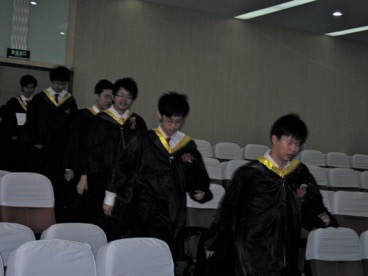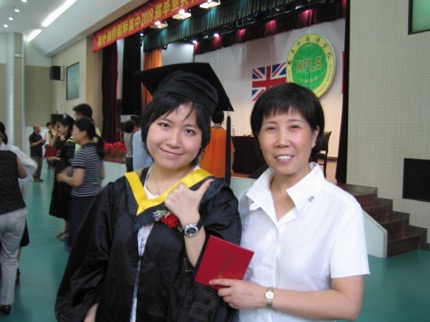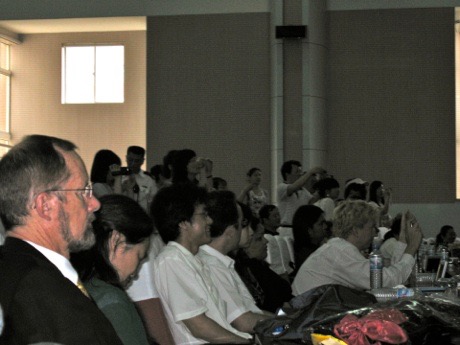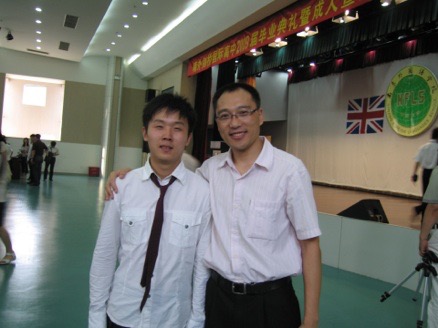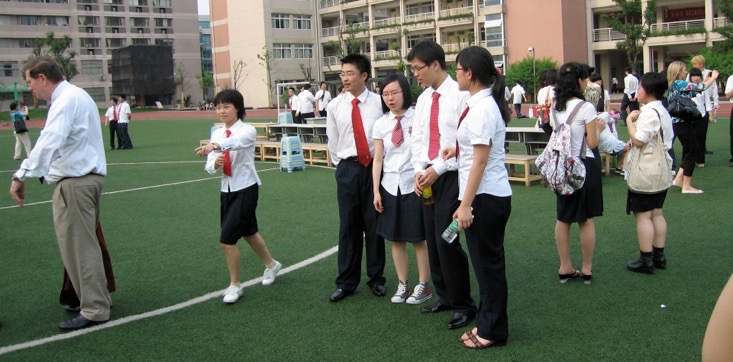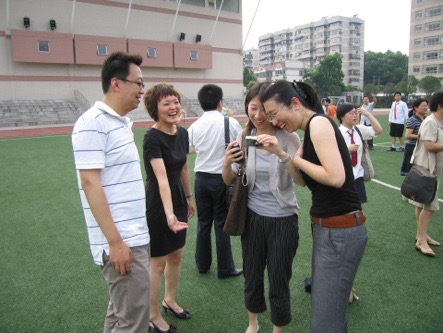At the end of their school year, Chinese students have a school ceremony not dissimilar from the US equivalent, but far, far from any British one. This commentary is based on the occasion viewed in Nanjing this year.
The A2 students have completed their exams and indeed have been on study leave since mid-May. This ceremony marks the end of their schooling but, more significantly, includes them being given their ‘graduation’ or completion certificate. This, inevitably, comes in a hard cover so it looks like a little red book (oops), around A5 size. Inside is a single sheet of official paper (official because it has inked stamps on it) that says the named student has completed their education at the named school in some satisfactory manner. It indicates no grading, only completion. Completion in itself means some minimum standards are reached. I am unaware of anyone being denied completion, so this may well be yet another case where the paper is important but the circumstance is not and the paper itself is of value but somehow the thing the paper stands for is not. Actually, the lack of the paper gives problems, as one is required to have finished (sorry, have proof that you have finished) your education. The reasoning is cultural, foreign and I do not claim to understand this at all completely.
This essential of the possession of this paper becomes the target and the target is the only lever used in threatening students for bad behaviour over the year. Worse, it appears that the academic requirements were probably filled a year ago, so only attendance and behaviour could have been at fault. Since no-one is excluded, the threat is patently an empty one. Clearly the threat would be worthwhile if there were previous transgressors to be held up as examples. The persistent absentees and the proven cheats still received their ‘diplomas’. So what is the worth of this? I do not understand this thinking.
I do, of course, have a fundamental disagreement with the idea of ‘graduation’ from school. I begin to understand that there must be a paper marking the exit from school, but I disagree at so many levels with the idea of entitlement to wear a gown and hood and mortarboard. I might think differently if the qualification was graduated (literally, grades given) or was even selective, but the limit of selection lies in getting into the school. So you can imagine how I feel at the students wearing a gown of at least exhibitioner (commoner, exhibitioner, scholar, graduate) rank, being a long gown, the greater annoyance at the gaudy (apologies to Oxonians, there) hood: the mortarboard I can disregard as the result of a misunderstood American influence (instantly denied when I suggest this). I notice the footwear and realise that the great heat and humidity mean that these students are wearing surprisingly little – it is not uncommon for there to be shorts, T-shirt and sneakers with the gown. Very few are wearing ‘proper’ dress at all so I stop being narked and try to be amused instead.
The performance starts with a grand entry to the lecture hall. A number of rows in the middle section have been kept clear and the students parade in to fill alternate rows from opposite directions (neat, if they’d moved at closer intervals). The room is otherwise filled with parents and other students. On the stage are three staff: the Head, myself and a lady who has come only for the first part of the official content. But first, having survived the entry process, we have two compères explaining and introducing. They do this well. We sing the National Anthem, facing the flag on the wall at the back of the stage. The stage also has the UK flag and a huge version of the school crest (it must be close to 3 metres across). Then we have the official lady visitor, who takes the kids through the oath of adulthood (my descriptor) and then vanishes from the stage. Next up is a picture file of memories which is repeated on screens around the room but does not include one that the Head and I can see, so we look consistently stupid, especially when (if) there are pictures of ourselves. I now have a file, that may be what was shown, in which many of the pictures are over a year old and so inappropriate to this cohort. Speeches follow the laughter. The Head, myself, a representative parent, a student in Chinese and a student in English. Each is bracketed by a bow to the audience. I am informed later that mine (speech, not bow) was perhaps too difficult – but I insist on saying something rather than contribute only froth.
Endured, not enjoyed. Throughout this phase there are people of all descriptions wandering around with cameras in a range of sizes as if showing what the market has to offer. For me the best picture is of the audience, itself largely behind its camera; my copy is of low quality.
Then we have the handing out of the diplomas. The kids are formed up in a queue to one side of the stage; they must take maybe ten steps, shake my hand, shake the Head’s hand, collect the little red book from the head and hold it against their chest while a photo is snatched of the three of us – and vanish fast before the next student arrives. As the Head said at the time, doing this for 70 is one thing, but he had to do it for 400 last week. The kids manage to screw this simple task up by lack of observation of the therbligs (look it up). They each need to grab my right hand and pass in front of me to meet the Head from the right angle. They need to collect the diploma with their left; they need to face the camera. They don’t want to fall over, drop anything, have any clothes fall off: their moment is recorded by the official photographer and by a host of amateurs standing on the apron of the stage - largely parents, but the sheer number taking many photos is confusing. The lack of familiarity with the form of dress shows. I see how few can tie a tie, how many have a clip-on tie, how many can’t even fasten their shirts. I marvel at the range of clothes being worn (or not) and I realise that some of these ‘shirts’ are only as complete as the little piece that is visible, maybe as much as an handkerchief.
After this, we move to more photos indoors. The photographer shows me briefly some he snatched in an off moment – my, he is good. The parents and students grab any and all staff for paired photos with their preferred adult, often trading cameras in pairs. This continues outside – an official year-group photo will demonstrate who of the staff was missing – and the photos continue for a further hour. During this time I am invited to dinner with the departing kids – a singular honour. This proves to be great fun and demonstrates a side of the kids I had not expected. While too many drink too much too fast, they stop at a point well within the bounds of good behaviour and no-one misbehaves. Yes, they are loud and rowdy but much less so than the equivalent UK kids. There are several muted apologies to the restaurant staff (now there’s a first) and quite a lot of rotation between tables as people manage to achieve a mingling that would not happen in the west without serious external effort. Conversation is wide-ranging and varies between the really intelligent and the uncouth banter, but with an unexpected distribution that would not be matched on other continents. I am impressed with the students. I definitely enjoyed the company.
Is this graduation? Of course it isn’t, and we all need a better word to describe the event and to mark the passing and its rites. There was very little silliness and much decorum. While several went on to party the night away, this was also done with a forethought I had not anticipated but am very glad to have seen.
DJS 20090725
DJS 20090623

